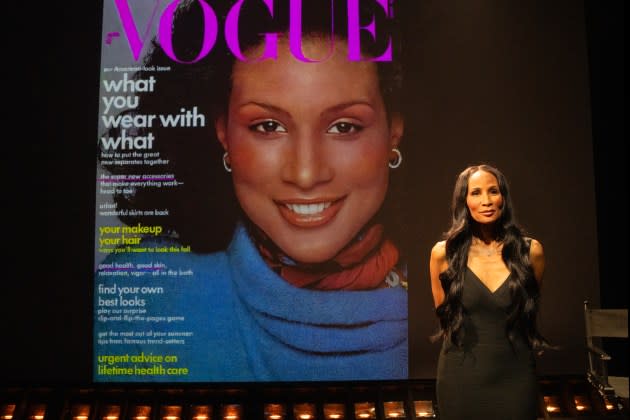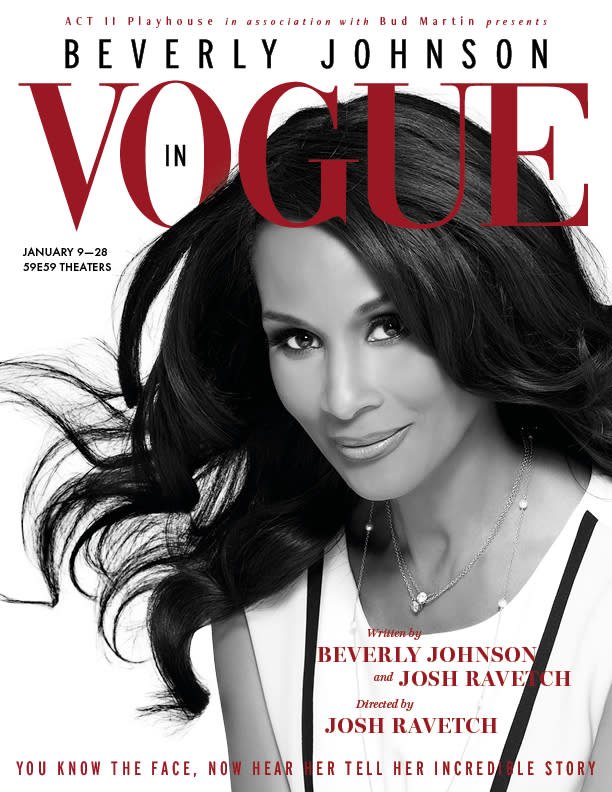Boundaries-breaking Model and Advocate Beverly Johnson Looks at Life and the Fashion Industry With a Critical Eye

Fifty years after Beverly Johnson became the first Black model to land a Vogue cover, she is still charging ahead through business, entertainment and diversity advocacy.
Her feats and challenges are highlighted in a just-opened one-woman show at 59E59 Theaters in New York. Running through Jan. 28, “Beverly Johnson in Vogue,” also explores her substance abuse struggles and allegations against Bill Cosby, who dropped a defamation suit against her in 2016. Following the murder of George Floyd, Johnson proposed that fashion, beauty and media corporations interview at least two Black professionals for each job opening. (The concept was suggested by her partner Brian Maillian and is derivative of “The Rooney Rule,” an affirmative action initiative enacted by Pittsburgh Steelers’ former chairman Dan Rooney in 2002.)
More from WWD
What to Watch: 2024 Could Be Another Darwinian Year for Legacy Media
Say Farewell to 'Rizz' and Other Words That Are Already Out of Fashion
During an interview Monday, Johnson was direct, but self-effacing and easygoing, detailing some of the more poignant moments of her life and sizing up the fashion industry. In addition to running a beauty business through Beverly Johnson Enterprises, licensing deals and making speaking engagements, she periodically appears on “The Barnes Bunch,” the reality show starring her daughter Anansa Sims with ESPN analyst fiancé Matt Barnes, and six children. “I’m Mary Poppins — I pop in, and I pop out,” she said.
Growing up “an introvert, an academic and a competitor on the first all-Black swim team,” Johnson said she envisioned a law career while studying at Northeastern University. Watching coverage of the Civil Rights movement with her “news junkie” father had set her on that path. He also influenced her view of diversity. While serving in the military, Johnson’s father picked up four languages. Although he worked full-time as a steel laborer, he did his friends’ taxes from the family’s kitchen table at no charge. “A Polish friend would come in with a string of Polish sausages slung over his shoulder to bring my dad for doing his taxes. An Italian friend would bring something else. It was from my father that I got that kind of worldly view,” she said. “They would come in the back door even though we lived in an all-white neighborhood. It was like the roles were changed. We used to have to go in the back door. They were friends as well. It made a really beautiful impression about diversity and the love of just people,” she said.
The fortitude needed for competitive swimming — never mind the walks home from practice with wet hair (handheld dryers were not yet a thing) in the frigid Buffalo winters — would later factor into her professional modeling. “I was going to be a lawyer. I’m an introvert and a nerd. I was on the honor roll. Every time I would walk across the stage [to be honored], everybody would boo me. I was the first Black cheerleader. I started the first Black students union,” she said. “I was not pretty. Girls who were pretty were short with big legs and a figure. I was tall, skinny and flat-chested. I wore my hair in two braids all through high school. Nobody was chasing me,” Johnson said.
Interested in AI and connecting with a range of generations, Johnson said, “I don’t call it aging. I call it ‘pro-aging,’ It’s like a treasure hunt.”
Johnson wrote the one-woman show a few years ago with playwright Josh Ravetch, whose credits include Carrie Fisher’s “Wishful Drinking,” “Onward: The Diana Nyad Story,” and Dick Van Dyke’s “Step in Time! A Musical Memoir.” Before the pandemic struck, Johnson’s show was well-received at a West Hollywood workshop, she said.
Mulling over how to celebrate the 50th anniversary of the Vogue cover was difficult to reckon with. “That’s half a century. It’s difficult to even say sometimes,” Johnson said.
Johnson said she has no idea why the cover happened (under the editorial stewardship of Grace Mirabella.) “I honestly think it was a fluke. In those days, you never knew if you had gotten the cover until you were on the cover,” she said.
She was hired in the spring of 1974 for a beauty shot with photographer Francesco Scavullo, stylist Frances Stein, hair stylist Suga and Way Bandy handling the makeup. “There was magic in the air for sure. But there was magic for a great beauty shot,” Johnson said. “Somebody just got the guts [to use the image for the history-making cover].”
Recalling the overwhelming reaction and being intereviewed for media “from all over the world,” Johnson said she only learned recently that Vogue was said to have done three production runs to keep up with demand. Re-sharing that and other personal stories including ones about adversity make people think “that if she can do it, I can do it,” Johnson said.

Celebrating the breakthrough Vogue cover “to give that moment in history that it deserves” was indirectly proposed by a gentleman via “Beverly’s Full House,” that used to air on the Oprah Winfrey Network, Johnson said. “You know how it is, you don’t want to blow yourself up — you want someone else to do it. But a closed mouth never gets fed,” she said. Despite having always spoken out about thornier topics like depression, hysterectomies and menopause, focusing on her fashion milestone was a new nexus.
Substance abuse and addiction are also addressed in the off-Broadway show by Johnson, who referred to the recent death of the actor Matthew Perry (by acute effects of ketamine) as an example of “how insidious the disease has become.”
“Recovery is sacred. What we learn in AA [Alcoholics Anonymous] is that it is not by promotion. It’s by example. They feel you should not present it to the public. I’m still in AA so I abided by the rules. Once in a while it would slip out. If someone asked if I would like a drink, I would say, ‘No, I don’t drink or use drugs ever.’ They would say, ‘Huh, excuse me?’” she said.
Her audiences are “laughing with me, crying with me,” she said.
As for how the fashion industry has advanced since Floyd’s murder in 2020, Johnson said there has been some movement with Black executives being appointed to corporate boards, but there is work to be done. “We’ve got such a long way to go. Every industry is a bubble in itself, but ours is really a tough little bubble to get into,” she said.
In terms of improving diversity, Johnson said that laws are needed “to make people do the right thing. That way they have consequence, if they don’t.” Johnson praised The Model Alliance and founder Sara Ziff for its support of The Fashion Workers Act, which calls for financial transparency and accountability in the modeling industry. “Listen, my agent, who I love, Iconic Focus, or with whatever other agencies that I have been with, there’s no transparency. I don’t know how much they’re getting. I have to depend on them, which I do. I want to think that everybody is honest. But transparency would be nice. It’s like we’re children and I am far from a child model. I can take it,” she said.
Johnson credited her father for teaching her to know to use her voice, “when she had leverage.”
After babysitting one day, Johnson recalled “fighting this guy off” after a man pushed her down on a bed and got on top of her. Nearly a decade later, Johnson said she confronted him, and “looked him dead in the eye and said right to his face, ‘Have you molested any little girls lately?’” she said. “That felt so good. He just got red and left. Confronting him gave me so much power.”
Johnson said Monday that incident at the age of 12 had led to her drinking alcohol for the first time and how she later “threw up at school.”
Johnson said sexual abuse is “a global dynamic,” and recalled an experience with Cosby, alleging he drugged a cup of coffee that he gave her. “It’s a miracle that both times [referring also to the babysitting altercation] I got out of there without being raped. Who knows if you would be talking to me on the phone right now, if I had been raped. It shuts women’s lives down — the trauma,” Johnson said, adding that she now deals with her personal trauma by giving back.
The advocate and model sits on the board of directors of Barbara Sinatra Children’s Center Foundation, where abused and sexually abused children are supported immediately with services.
Looking ahead five years, Johnson is wary to speculate about how the fashion industry might change. “I don’t expect anything. All I do is what little I can do — talking to you about or to a model, who had a bad experience and ran away from it because she’s traumatized. We’re talking about young women, but it’s not just young little models,” Johnson said. “There are hairdressers and men. The modeling industry is the Wild, Wild West in that waitresses and auto workers have unions. There are unions for industries. We are a trillion [dollar] industry, but there are no rules.”
Johnson’s outspokenness isn’t anything new. She described approaching a heavy-hitting cigarette-smoking pr executive about representing her in the 1970s. “He said, ‘What do you have to talk about with the press? You’re a model. Unless you’re going to throw red wine on Jacqueline Kennedy’s white pants to try to get some press, what’s there to talk about?’”
Despite the executive was so resistant that he told Johnson he didn’t want to take her money, but she insisted and paid him about $600 a month. Two months later she landed the Vogue cover, and the prs flew into action, prepping her for interviews with the media. Sometimes they interrupted “to explain what she meant.’ Johnson recalled with a laugh. “I was a bit of a firecracker even then.”
Best of WWD

